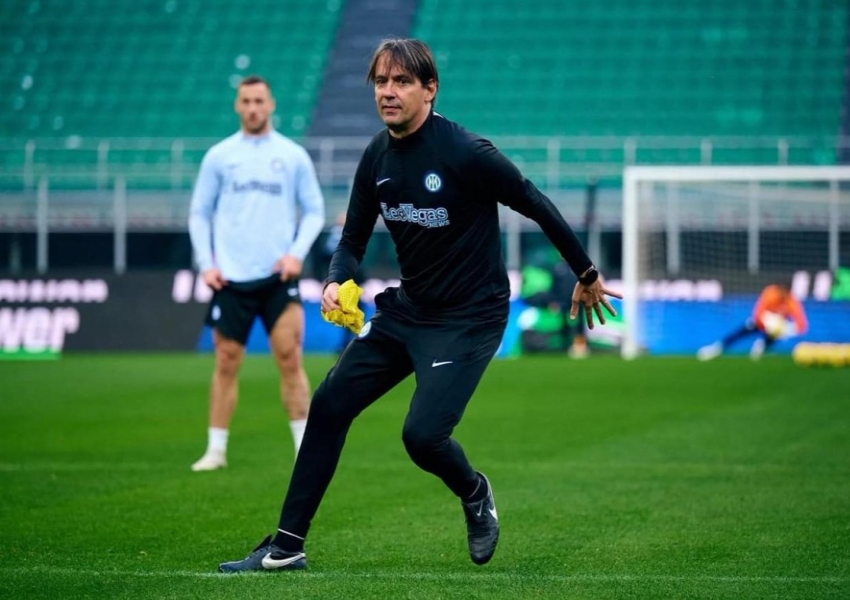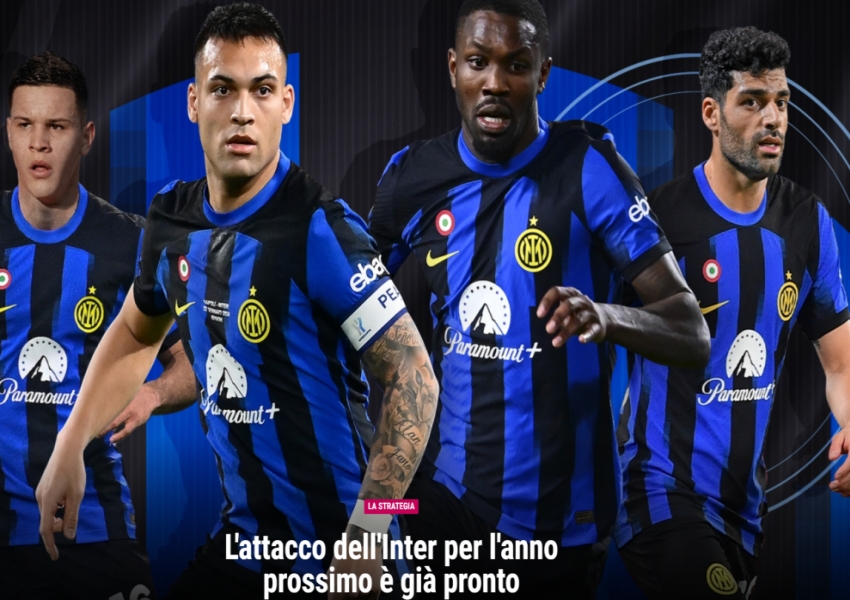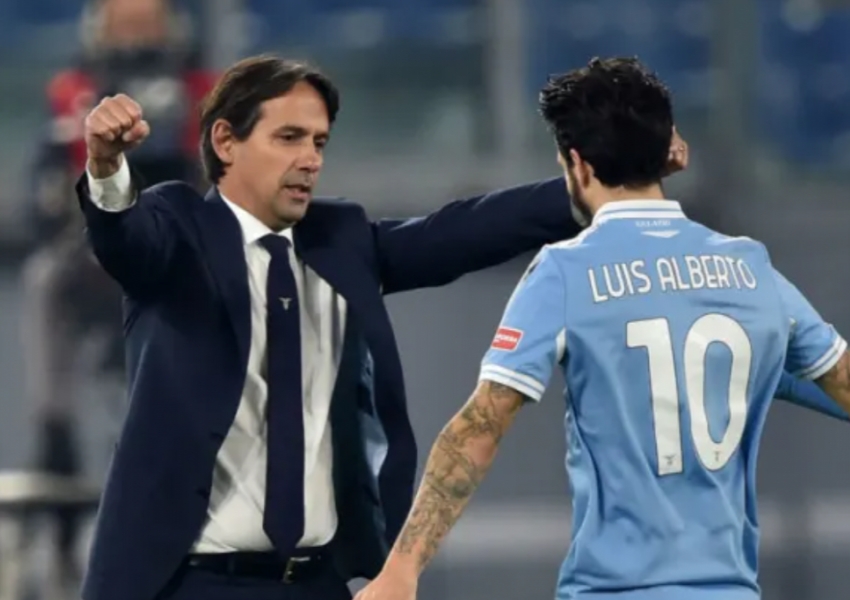Inter Milan Faces a Three-Year Weakness: Can Simone Inzaghi’s Preferences Solve the 4.5th Striker Problem?
After defeating Juventus, Inter Milan finds itself in a favorable position. Despite this, the Italian media is relentlessly scrutinizing the club, particularly focusing on the refinancing issue with Oak Tree Capital. However, as previously mentioned, feedback from Jiangsu suggests that the refinancing problem is manageable. The Zhang family is simply waiting for a more favorable market interest rate before finalizing the deal. This article, however, highlights a different challenge—the pressing issue of Inter's substitute strikers.

Simone Inzaghi’s Striker Conundrum
Italian television has recently zoomed in on Inter’s head coach, Simone Inzaghi, particularly noting his intense frustration during the Juventus match when Marko Arnautović missed a critical opportunity. In recent training sessions, Inzaghi, a former forward himself, has frequently taken to the field to personally guide Arnautović on technical details. This highlights the coach’s deep concern over Arnautović’s form. The coaching staff’s primary worry is the performance of Inter's backup strikers.

In the match against Juventus, Inter’s substitutes performed reasonably well, especially compared to Juventus’s higher-priced bench players. However, Arnautović’s repeated failure to capitalize on golden opportunities has not eased the controversy surrounding his high transfer fee, especially given his age. The primary strike duo of Lautaro Martínez and Marcus Thuram is performing excellently, but with the club now leading by four points with a game in hand, more focus will inevitably shift to the Champions League knockout stages. Given Inter’s financial situation, advancing in the Champions League is crucial for earning substantial revenue. Therefore, the importance of effective rotation players becomes even more pronounced.

Rotational Player Strategy
Inzaghi’s attention is already shifting towards rotational strategies. For example, while Benjamin Pavard’s recent performances have been outstanding, it has come at the expense of Valentin Carboni’s playing time, which has been reduced to just a few minutes in recent matches. Additionally, Davy Klaassen’s reappearance after a month and six days in the Derby d’Italia indicates that the coach hasn’t completely given up on him. This reflects the need for contributions from rotation players in a squad with an average starting age of 29 years and 327 days, as relying on just 12-13 players is unrealistic for the dual-front challenges over the next four months.
The Critical Role of the Backup Striker
The biggest challenge for Inter this season lies in the performance of their backup strikers. The recent free signing of Mehdi Taremi to replace Alexis Sánchez next season is a step towards addressing this issue. "La Gazzetta dello Sport" has dedicated an article to discussing the composition of Inter’s forward line for next season, particularly debating the necessity of a “fifth striker” or, more accurately, a “4.5th striker.”
For a team playing a 3-5-2 formation and competing on three fronts, having four strikers seems adequate, provided all four are effective. However, if one or two underperform, the frontline will inevitably struggle. Inter has suffered from this issue over the past few years, notably with players like Joaquín Correa and Arnautović. The inadequacy of rotational strikers has been a persistent problem during Inzaghi’s three-year tenure.
The Solution: A Fifth Striker?
Adding a fifth striker could be a solution, but this player must meet stringent criteria. They must have a low salary, given Inter’s financial constraints, and possess sufficient skill to be effective in limited playing time. Furthermore, they need to be a type of player the coach favors; otherwise, they risk being forgotten on the bench.
"La Gazzetta dello Sport" suggests that Valentin Carboni could fit this role. There is internal support for recalling Carboni next season to serve as a backup striker. However, some argue that bringing back a promising young player for such a role could hinder his development, citing his mere six appearances totaling 50-60 minutes last season as evidence. Nonetheless, Carboni’s versatility has grown since joining Monza, where he developed his midfield skills. This dual capability increases his viability for next season, as a player who can rotate in both midfield and forward positions will naturally see more playing time.
Inzaghi’s Preferences: Key to Solving the Striker Issue?
Inzaghi’s coaching preferences might hold the key to resolving this issue. He has two notable inclinations: a penchant for target men and a strong preference for technically gifted, versatile players. At Lazio, Luis Alberto fit this mold, and at Inter, Henrikh Mkhitaryan, Federico Dimarco, Hakan Çalhanoğlu, and Matteo Darmian have been favored for their versatility.
Carboni, too, fits this profile. Given the uncertainties surrounding Arnautović and Correa, could the Argentine youngster be the solution to Inter’s longstanding striker rotation problem? "La Gazzetta dello Sport" believes there is hope.
Balancing Age and Experience
Inter’s current squad is among the oldest in Serie A, and managing this age factor is crucial. While experience is invaluable, the physical demands of competing on multiple fronts require a careful balance. The integration of younger, versatile players like Carboni could provide the necessary dynamism and reduce the burden on older players. This approach not only addresses immediate tactical needs but also ensures a smoother transition in the squad’s long-term composition.
Financial Implications
The financial aspect cannot be overlooked. Inter's fiscal strategy, heavily influenced by owner Steven Zhang, necessitates prudent financial management. The club’s ability to retain key players like Lautaro Martínez and acquire strategic signings hinges on a delicate balance of expenditure and revenue generation. Advancing in the Champions League is pivotal for financial stability, underscoring the importance of effective squad rotation to maintain competitive performance across all competitions.
Tactical Flexibility
Inzaghi’s tactical flexibility will be tested in the coming months. His ability to adapt strategies based on available personnel and match demands will be crucial. The use of versatile players like Carboni in multiple roles can provide the tactical depth needed to navigate the challenges ahead. This flexibility not only enhances matchday options but also fosters a competitive environment within the squad, driving players to elevate their performances.
The Road Ahead
As Inter Milan navigates the remainder of the season, the focus on squad rotation and effective utilization of backup strikers will be paramount. The strategic integration of players like Carboni, combined with Inzaghi’s tactical acumen, holds the potential to address the club’s longstanding issues and propel them towards both domestic and European success. The upcoming months will be a litmus test for Inzaghi’s ability to balance experience with youthful dynamism, ultimately determining Inter’s fortunes on both fronts.
Copyright Statement:
Author: mrfootballer
Source: Mrfootballer
The copyright of this article belongs to the author. Reproduction is not allowed without permission.
Recommended Blog
- Serie A Round 24: Are Juventus Destined to Accept Their Fate? Udinese Faces Biggest Relegation Crisis of the Century
- Atletico Madrid Stirs Psychological Warfare Before Inter Clash: Simeone Laments Injustice, Reveals Battle Strategy
- Premier League Round 24: Dark Horse Dreams Fade as Arsenal and Manchester United Charge Forward
- Inter Milan Dominates Serie A's Big 7: 9 Wins, 1 Draw, and a Mysterious Halftime Communication
- La Liga Round 24: Real Madrid’s Defensive Shuffles and Real Sociedad’s Scoreless Streak
- Inter Milan’s Departing Hero: Klaassen’s Pure Desire Demonstrates Great Qualities
- Bundesliga Round 21: Dortmund Brewing a Big Win, Leipzig Can't Afford to Overlook Real Madrid
- Celebrating the Lunar New Year with Inter Milan's Trio of Joyous News: Post-Moratti Era Breakthroughs and Steering Away from Juventus
- Inter Milan's Crucial Visit to Madrid: Key Negotiations and Scouting Opportunities
- Emphasizing Speed: The Tactical Similarities and Differences Between Jordan and Qatar, and the Future of Asian Football
Hot Blog
- Man City’s 21-Year-Old Star Returns Home as a Hero! Receives $350,000 Mercedes, Gifts It to His Father
- AFC Champions League Quarterfinal Draw: Yokohama Faces CR7! Two High-Stakes Clashes as Japan’s Duo Battle in the Bottom Half
- A Night of Triumph and Heartbreak: Barça’s Epic Comeback, Liverpool’s Cup Final Agony, and Leverkusen’s Stunning Reversal
- 175 Days on the Sidelines! Barça’s 32-Year-Old Guardian Dreams of a Champions League Comeback
- Barça Unleashed: 26-Minute, 4-Goal Comeback Stuns Atlético as Flick’s Masterclass Makes History
- Simeone’s 8 Days of Nightmare: Champions League Exit and Two La Liga Collapses
- Messi Turns Magician with Both Feet: A 3-Second Masterclass That Left Three Defenders Helpless
- From 0-2 to 4-2! Barça’s Miracle at the Metropolitano: Injury-Time Heroics Seal Stunning Comeback and La Liga Top Spot
- English Media: Manchester United Will Win Premier League Title in 2028! History Will Repeat Itself, Two Teams Serve as Inspirations
- 7 Players Dropped, 2 New Additions! China’s National Team Surprises with Key Reinforcements and a Full-Strength Squad